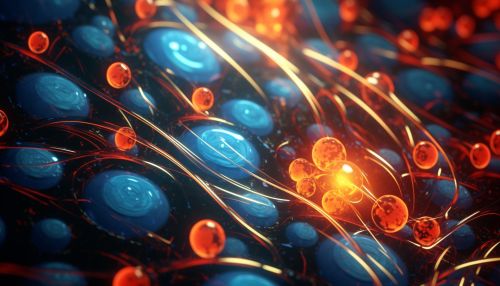Intercellular communication
Overview
Intercellular communication is a critical process that enables cells within an organism to communicate with each other. This communication is essential for coordinating cellular activities and maintaining homeostasis. It involves the transmission of signals from the signaling cell to the target cell, which can be a neighboring cell (paracrine signaling) or a cell in a distant organ (endocrine signaling). The signals can be in the form of small molecules, proteins, or ions, and are transmitted via various mechanisms, including gap junctions, exosomes, and synaptic signaling.


Signal Molecules
Signal molecules, also known as ligands, are substances that bind to specific receptors on the target cell's surface, initiating a response. These can be small molecules like nitric oxide, larger proteins like insulin, or even ions like calcium. The nature of the signal molecule determines the type of receptor it will bind to and the subsequent cellular response.
Receptors
Receptors are proteins located on the cell surface or within the cell that bind to specific signal molecules. The binding of a signal molecule to its receptor triggers a series of events within the cell, leading to a specific response. There are several types of receptors, including G-protein coupled receptors, ion channel receptors, and intracellular receptors.
Signal Transduction
Signal transduction is the process by which the signal is transmitted from the receptor to the effector molecules within the cell. This involves a series of reactions known as a signal transduction pathway, which amplifies the signal and leads to a specific cellular response. The signal transduction pathway can involve various molecules, including enzymes, second messengers, and transcription factors.
Mechanisms of Intercellular Communication
There are several mechanisms through which cells communicate with each other. These include:
Direct Contact
In some cases, cells communicate through direct contact. This can occur through gap junctions, which are channels that directly connect the cytoplasm of two cells, allowing for the exchange of ions and small molecules. Another form of direct contact is through cell-cell adhesion, where cells bind to each other through specific proteins on their surface.
Paracrine Signaling
In paracrine signaling, the signal molecules are released by the signaling cell and bind to receptors on nearby cells. This type of signaling is common in tissue repair and inflammation.
Endocrine Signaling
In endocrine signaling, the signal molecules, known as hormones, are released into the bloodstream by endocrine glands and can affect cells in distant parts of the body.
Synaptic Signaling
In synaptic signaling, the signal molecules, known as neurotransmitters, are released by neurons and bind to receptors on other neurons, muscle cells, or gland cells. This type of signaling is critical for the functioning of the nervous system.
Role in Health and Disease
Intercellular communication plays a crucial role in maintaining the health of an organism. Disruptions in this communication can lead to various diseases, including cancer, autoimmune diseases, and neurological disorders. For instance, in cancer, the communication between tumor cells and normal cells can promote tumor growth and metastasis. In autoimmune diseases, faulty communication can lead to the immune system attacking the body's own cells.
Future Directions
Research in intercellular communication continues to uncover new mechanisms and pathways, providing potential targets for therapeutic intervention. For instance, the role of exosomes in intercellular communication is a rapidly growing field, with potential implications for cancer therapy and regenerative medicine.
